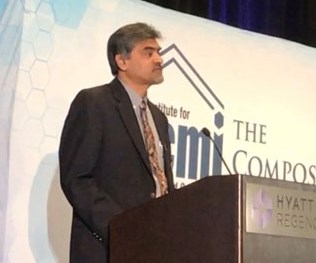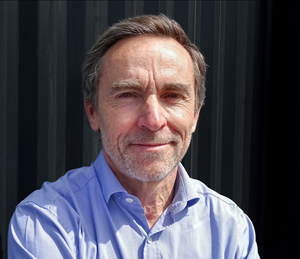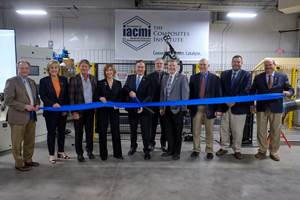Developing new solutions for noise, vibration and harshness
Several recent IACMI partner projects focus on technology innovation related to challenges in noise, vibration and harshness (NVH) in vehicle design.

Uday Vaidya, Chief Technology Officer at IACMI
IACMI — The Composites Institute (Knoxville, Tenn., U.S.) and its project partners have been making significant progress over the past five years, following IACMI’s technology roadmap, in areas already discussed in previous columns this year, such as efforts to reduce the embodied energy of composites, improvements to composites’ recyclability and new solutions for multimaterial joining. Another focus for IACMI projects is reduction of noise, vibration and harshness (NVH) in automotive applications.
Despite enabling energy savings and emissions reductions from lower fuel levels, automotive lightweighting can contribute to unfavorable NVH in vehicle operation.
NVH is most commonly managed through absorption of acoustic energy by physical structures. The comparison of effectiveness of energy absorption between materials is determined by complex relations between physical and design factors, such as mechanical properties, density, intrinsic structure, as well as component geometry, connections and loading. Vehicle mass reduction can be a zero-sum game for automakers in cases where a light material is directly substituted in an existing design, but additional mass is required to meet NVH requirements. Addressing NVH early in the design for a new material can help realize a positive impact on weight, cost and energy.
With respect to IACMI’s goals, NVH challenges directly impact the overall cost of deploying carbon fiber-reinforced polymers (CFRP). While NVH challenges are embodied in passenger sound and ride quality in automotive applications, acoustic energy can also negatively impact rotor rotation speeds in wind turbine applications. Managing NVH costs is easiest if addressed early in product and process design using predictive modeling tools and integrated design approaches.
Considering all aspects of advanced composites integration is important for implementation into the automotive market.
IACMI and its members have identified a range of topical focus areas important for achieving IACMI’s technical goals while also addressing NVH challenges:
- Novel fabrication techniques and advanced lay-up methods can enable highly tailored structures and fiber orientations that improve NVH quality in composites.
- Comprehensive simulation tools and software suites can help address NVH challenges throughout the composite lifecycle — from design, to validation, initial manufacture, use through end-of-life (EOL), recycling and reuse.
- Dynamic material and structural characterization methods improve the accuracy of predictive modeling tools to better control NVH performance costs during early design stages.
- Systems-level design and process modeling approaches permit greater control of early-stage NVH performance through concurrent simulation-based experimental design of materials, components and structures, and their respective manufacturing processes.
- Multimaterial design methods and joining technologies can simultaneously permit the selective integration of new high-performance composites while helping to solve core NVH issues.
- Unique fiber architectures, additively manufactured structural cores, and embedded sensor technologies can help solve NVH issues for automotive and wind turbine applications.
To help guide industry-led technology demonstration projects toward achievable NVH solutions, IACMI and its members co-developed a strategy with the following objectives:
- Align NVH project proposals with industry needs. Industry stakeholders recognize that increased NVH performance helps to boost the adoption and market pull for advanced composites. IACMI will continue to support project opportunities that propose to solve core NVH challenges and reduce downstream change-related costs.
- Proactively address NVH in early product and process design to reduce change-related costs. Integrated design approaches that combine predictive modeling tools with dynamic material/structural characterization approaches can help composites manufacturers proactively control NVH performance costs during the early stages of product design. Demonstrating these cost savings will help promote and accelerate the adoption of composite materials for automotive and wind turbine applications.
- Leverage IACMI’s unique vertically integrated partnerships. NVH challenges are driven by many systems factors, including multi-component composites structures, adhesives, and intermediates, and their respective manufacturing processes. IACMI will continue to facilitate collaborative relationships across the composites manufacturing supply chain to address key NVH needs while delivering lighter composites for automotive and other application markets.
Considering all aspects of advanced composites integration in novel ways – such as how NVH impacts the vehicle and user experience – is important for the implementation of composites into the automotive market. Through better understanding the factors that impact NVH, IACMI can lead industry research to solve problems and continue to drive lightweighting of the automotive sector.
Related Content
People in composites: April 2023
Concordia Engineered Fibers, Nawa Technologies, IACMI, Joby Aviation and Akarmak America have made new personnel announcements in April 2023.
Read MoreIACMI receives funding renewal from U.S. DOE to continue composites R&D
Over the next five years, IACMI aims to further composites R&D efforts to support U.S. decarbonization and its pillars: technology, economy and workforce development.
Read MoreIACMI names Chad Duty as CEO
Duty will fully assume his new role as CEO in April 2023, while continuing his position as an engineering professor at the University of Tennessee, Knoxville.
Read MoreThe state of recycled carbon fiber
As the need for carbon fiber rises, can recycling fill the gap?
Read MoreRead Next
Composites end markets: Energy (2024)
Composites are used widely in oil/gas, wind and other renewable energy applications. Despite market challenges, growth potential and innovation for composites continue.
Read MoreCW’s 2024 Top Shops survey offers new approach to benchmarking
Respondents that complete the survey by April 30, 2024, have the chance to be recognized as an honoree.
Read MoreFrom the CW Archives: The tale of the thermoplastic cryotank
In 2006, guest columnist Bob Hartunian related the story of his efforts two decades prior, while at McDonnell Douglas, to develop a thermoplastic composite crytank for hydrogen storage. He learned a lot of lessons.
Read More
















.jpg;maxWidth=300;quality=90)







